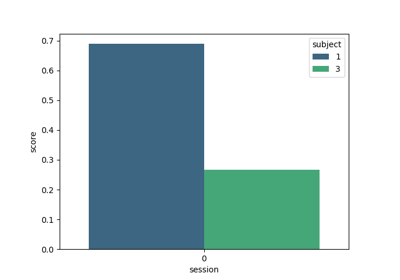moabb.datasets.MAMEM3#
- class moabb.datasets.MAMEM3[source]#
SSVEP MAMEM 3 dataset.
PapersWithCode leaderboard: https://paperswithcode.com/dataset/mamem3-moabb
Dataset summary
#Subj
#Chan
#Classes
#Trials / class
Trials length
Sampling rate
#Sessions
10
14
4
20-30
3s
128Hz
1
Dataset from [1].
EEG signals with 14 channels captured from 11 subjects executing a SSVEP-based experimental protocol. Five different frequencies (6.66, 7.50, 8.57, 10.00 and 12.00 Hz) have been used for the visual stimulation, and the Emotiv EPOC, using 14 wireless channels has been used for capturing the signals.
Subjects were exposed to flickering lights from five magenta boxes with frequencies [6.66Hz, 7.5Hz, 8.57Hz, 10Hz and 12Hz] simultaneously. Prior to and during each flicking window, one of the boxes is marked by a yellow arrow indicating the box to be focused on by the subject. The Emotiv EPOC 14 channel wireless EEG headset was used to capture the subjects’ signals.
Each subject underwent a single adaptation period before the first of their 5 sessions (unlike experiment 1 in which each session began with its own adaptation period). In the adaptation period, the subject is exposed to ten 5-second flickering windows from the five boxes simultaneously, with the target frequencies specified in the FREQUENCIES3.txt file under ‘adaptation’. The flickering windows are separated by 5 seconds of rest, and the 100s adaptation period precedes the first session by 30 seconds.
Each session consisted of the following: For the series of frequencies specified in the FREQUENCIES3.txt file under ‘sessions’: A 5 second window with all boxes flickering and the subject focusing on the specified frequency’s marked box, followed by 5 seconds of rest. Between the 12th and 13th flickering window, there is a 30s resting period. This gives a total of 25 flickering windows for each session (not including the first adaptation period). Five minutes of rest before the next session (not including the 5th session).
The order of chosen frequencies is the same for each session, although there are small-moderate variations in the actual frequencies of each individual window.
Note: Each ‘session’ in experiment 1 includes an adaptation period, unlike experiment 2 and 3 where each subject undergoes only one adaptation period before their first ‘session’ [2].
Waveforms and Annotations File names are in the form U0NNn, where NN is the subject number and n is a - e for the session letter or x for the adaptation period. In addition, session file names end with either i or ii, corresponding to the first 12 or second 13 windows of the session respectively. Each session lasts in the order of several minutes and is sampled at 128Hz. Each session half and adaptation period has the following files: A waveform file of the EEG signals (.dat) along with its header file (.hea). An annotation file (.win) containing the locations of the beginning and end of each 5 second flickering window. The annotations are labeled as ‘(’ for start and ‘)’ for stop, along with auxiliary strings indicating the focal frequency of the flashing windows.
The FREQUENCIES3.txt file indicates the approximate marked frequencies of the flickering windows, equal for each session, adaptation, and subject. These values are equal to those contained in the .win annotations.
Trial manipulation: The trial initiation is defined by an event code (32779) and the end by another (32780). There are five different labels that indicate the box subjects were instructed to focus on (1, 2, 3, 4 and 5) and correspond to frequencies 12.00, 10.00, 8.57, 7.50 and 6.66 Hz respectively. 5 3 2 1 4 5 2 1 4 3 is the trial sequence for the adaptation and 4 2 3 5 1 2 5 4 2 3 1 5 4 3 2 4 1 2 5 3 4 1 3 1 3 is the sequence for each session.
Observed artifacts: During the stimulus presentation to subject S007 the research staff noted that the subject had a tendency to eye blink. As a result the interference, in matters of artifacts, on the recorded signal is expected to be high.
References
- 1
MAMEM Steady State Visually Evoked Potential EEG Database https://archive.physionet.org/physiobank/database/mssvepdb/
- 2
S. Nikolopoulos, 2016, DataAcquisitionDetails.pdf https://figshare.com/articles/dataset/MAMEM_EEG_SSVEP_Dataset_III_14_channels_11_subjects_5_frequencies_presented_simultaneously_/3413851 # noqa: E501
